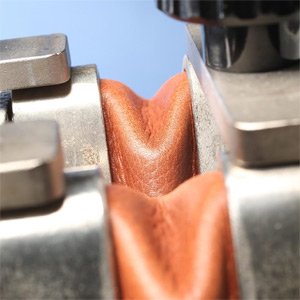Test Method: SATRA TM25
Vamp flex test - resistance to creasing and cracking
February 2020

SCOPE
This method is primarily intended to determine the propensity for materials to crack or otherwise fail at flexing creases, but can also be used to assess whether leathers are likely to produce salt spue. In particular the test simulates conditions in the vamp part of footwear during walking. The test can be conducted with either wet or dry specimens at room temperature or with dry specimens at sub-zero temperatures. The method is applicable to all flexible materials and in particular those used to manufacture outers and linings of footwear uppers such as leathers, coated fabrics and textiles.
PRINCIPLE
A square specimen of the material is folded over two inverted V-shaped clamps. The clamps are able to move relative to one another so that as they become closer the specimen is flexed to produce one downward crease surrounded by four upward creases, (see cover photograph and Figure 1). During the test the clamps oscillate at a constant speed so that the specimen is repeatedly flexed. The test can be carried out with either wet or dry specimens at room temperature or dry specimens at sub-zero temperatures. After a predetermined number of cycles the test is stopped and the specimen is visually examined for signs of damage or salt spue.
REFERENCES
This Test Method does not reference any additional Standards or Test Methods.
HISTORY
First issued October 1965. Revised March 1975, December 1980, May 1992, February 2020.
AVAILABILITY
This test method is available to members and non-members.
PRICE (ex. VAT)
This price is for a printed copy of the Test Method.
- Members: £84
- Non-members: £242


 EN
EN ZH
ZH